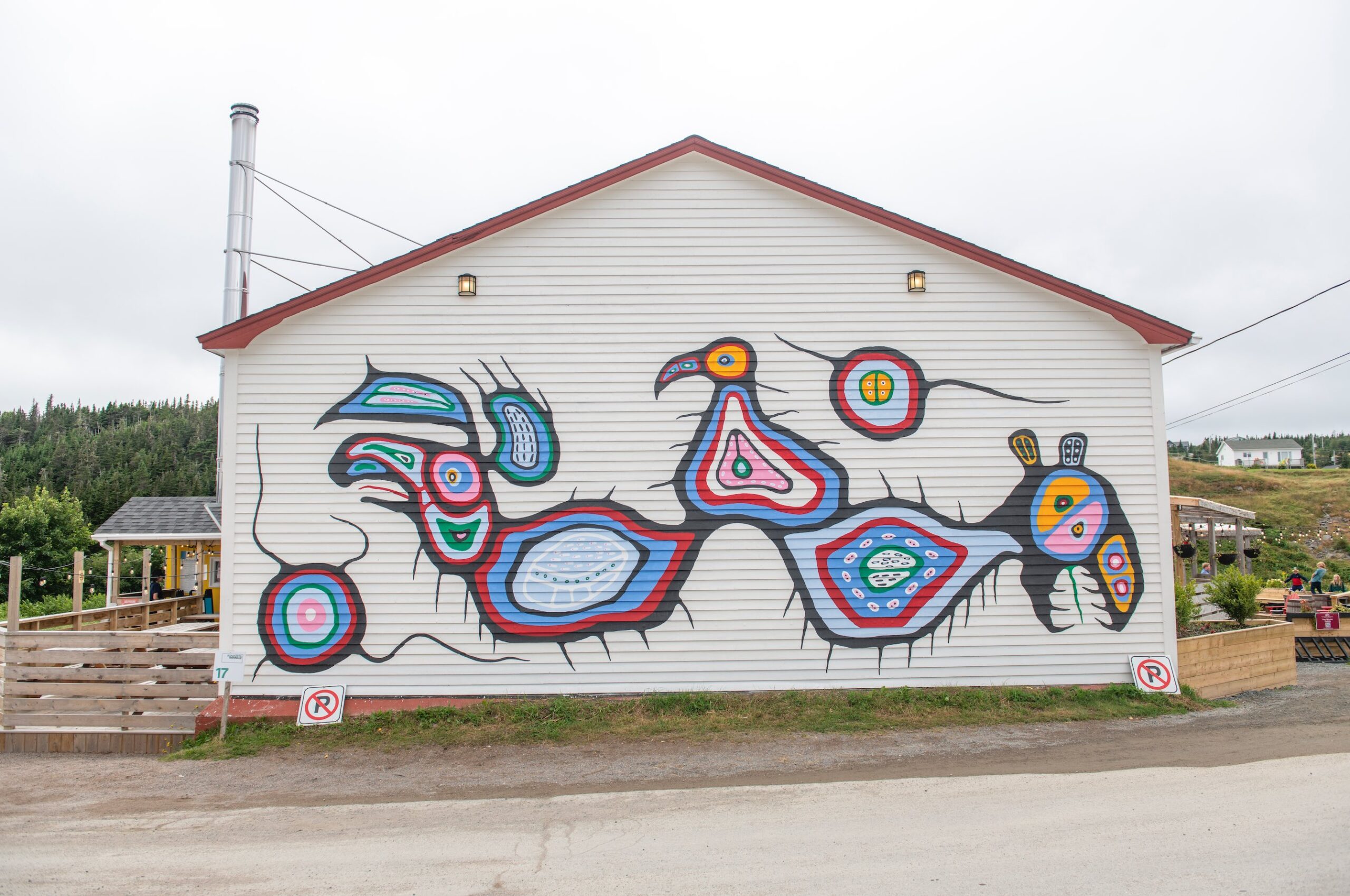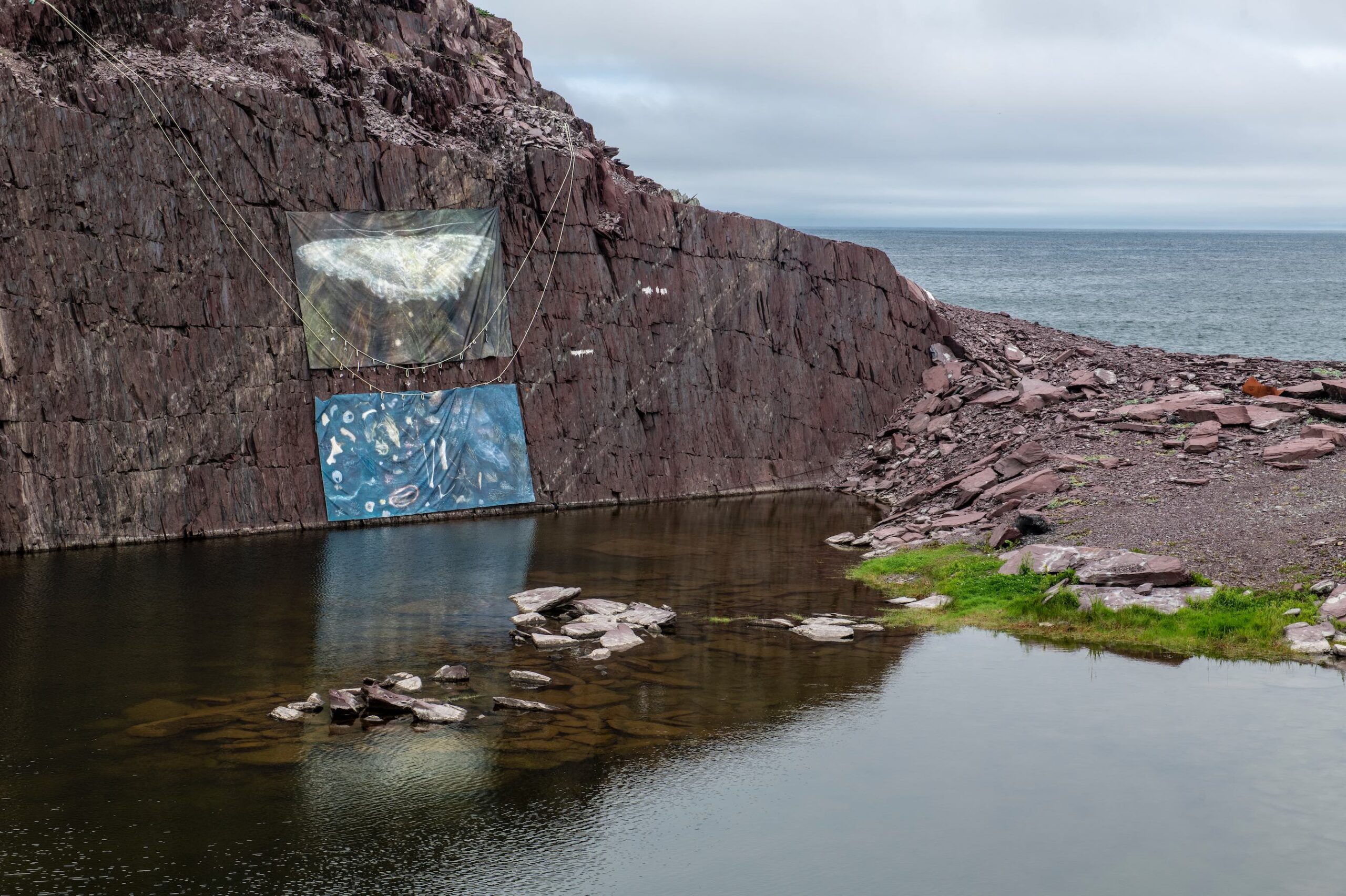A meeting point between people, perspectives and life forms, this year’s Bonavista Biennale seamlessly blended contemporary art, breathtaking landscapes and captivating narratives along the dramatic coastline of Newfoundland and Labrador
 Photography by Brian Ricks, courtesy of Bonavista Biennale featuring Born in the North, Provider, 2023, latex paint on clapboard. Installation view, 2023 Bonavista Biennale: Host
Photography by Brian Ricks, courtesy of Bonavista Biennale featuring Born in the North, Provider, 2023, latex paint on clapboard. Installation view, 2023 Bonavista Biennale: Host
Words by Evan Pavka
Steeped in years of complex histories, remote heritage sites are rife with potential for intervention. The near surreal landscape of Ktaqmkuk, the traditional Mi’kmaw territories now known as Newfoundland, is no different: Precambrian rock with fossilized remains dotted by spartan saltbox houses, wooden public buildings and weathered edifices that have witnessed the ebb of floe of tides, industries and colonial narratives. It’s a lure that the Bonavista Biennale — a biannual event along the rugged coast of the area’s Bonavista Peninsula — has leveraged and subverted since its inception in 2017. Now in its fourth edition, the sprawling exhibition (encompassing some 20 outdoor and architectural sites) deploys the area’s distinct vernacular to probe shifting economic, political and natural climates.
Themed Host (a culture, a role, a site, a condition of necessity for a rural region relying heavily on tourism), curators Rose Bouthillier and Ryan Rice assembled 23 artists to explore ‘not only the land as our host, but who are the original hosts and who are the uninvited guests,’ according to Bouthillier as well as ‘how those different relationships are played out today.’ Nowhere is this more apparent than Don Kwan’s deceptively quotidian This land is my land, this land is your land, an ouroboros of fluorescent red Muskoka chairs — a typology and colour synonymous with the mythologies of Canadiana — joined arm in arm on a manicured lawn.
As if constantly consuming itself, each throne seems to suggest another wave of immigration that has defined the country’s history, a fabricated national identity cyclically ingesting and displacing. The configuration further positions sitters face to face with one another, revealing a shared community that has become increasingly important as human-wrought environmental impact sets forests ablaze. Here, the everyday objects stand in for codependent industries and peoples as well as the seen and unseen bonds between many ways of life.
 Photography by Brian Ricks, courtesy of Bonavista Biennale featuring SK Maston, Deep Time Drift (beaks hid in the hole a seal fin, rib bone, rabbit paw fur), 2023, acrylic on printed canvas, rope, aluminum casts. Installation view, 2023 Bonavista Biennale: Host
Photography by Brian Ricks, courtesy of Bonavista Biennale featuring SK Maston, Deep Time Drift (beaks hid in the hole a seal fin, rib bone, rabbit paw fur), 2023, acrylic on printed canvas, rope, aluminum casts. Installation view, 2023 Bonavista Biennale: Host
Elsewhere, al fresco installations directly engage the cultural terrain. Along the cliffs near the nineteenth-century settlement Maberly, Host(age) (a deployable structure supported by splayed PVC pipes referencing historic fish flakes and perhaps poised to accommodate a wave of inevitable climate refugees) by architect K. Jake Chakasim joins Couzyn van Heuvelen’s enlarged fishing lures suspended from the rugged shore to gesture to the socio-economic fallout of the 1992 ban on cod harvesting to which the Biennale’s origin is tied.
Unlike similar exhibitions entered on consumable or captured experiences, Host and its contents are a deliberately slow addition to the accumulating presence of past mountings and local arts ecology. With no expedited responses spat from ChatGPT, it resists the impulse for easy answers. Instead, there are conversations, many of them, involving ‘building deeper local relationships’ and ‘contributing to economic growth in a sustainable and mindful way,’ Bouthillier adds. These are met by sensitive practices aligned with natural rhythms, from Shawn O’Hagan’s year-long dyeing experiments and Wally Dion’s quartet of quilts aggregating air-born sediments from the prairies to the Atlantic to Shirley Moorhouse’s hand-sewn telescopic wallhangings of the night sky and Ethel Brown’s family album archiving the quiet ageing of her children.
Ultimately, the productive tension between charged historic infrastructure and contemporary activation is the Biennale’s greatest resource, reminding us of scales of time, space and stories — of our role as guests and our continued responsibilities to our many hosts. Only a few kilometres south of the bronze statue of Italian navigator Giovanni Caboto commemorating his ‘discovery’ of new land 500 years ago, Host turns small, often overlooked moments like those captured by Brown into new monuments.
Get a curated collection of design and architecture news in your inbox by signing up to our ICON Weekly newsletter
















